Artificial-Crack-Behavior Test Evaluation of the Water-Leakage Repair Materials Used for the Repair of Water-Leakage Cracks in Concrete Structures
Abstract
:1. Introduction
2. Artificial-Crack-Behavior Test Method
2.1. Overview
2.2. Artificial Cracks
2.3. Micro-Behaviors of the Artificial Cracks
2.4. Artificial-Crack Specimens
(1) Upper-Substrate Details
(2) Lower-Substrate Details
(3) Acrylic Band for Connecting the Upper and Lower Parts
3. Repair Materials
4. Performance Evaluation of Water Leakage Repair Materials
4.1. Injection of Water Leakage Repair Materials
4.2. Specimen Installation for the Crack Behavior and Permeability Tests
4.3. Crack Behavior and Permeability Tests
(1) Crack Behavior Test
(2) Permeability Test
4.4. Test Results
(1) Synthetic-Rubber-Based (RG) Repair Materials
(2) Cement-Based (CG) Repair Materials
(3) Acrylic-Based (AG) Repair Materials
(4) Epoxy-Based (EG) Repair Materials
(5) Urethane-Based (UG) Repair Materials
4.5. Discussion
5. Conclusions
Acknowledgement
Author Contributions
Conflicts of Interest
Abbreviations
| KS | Korean industrial Standards |
| ISO | International Organization for Standardization |
| TR | Technical Report |
| RG | Synthetic-rubber-based repair materials Grouting |
| CG | Cement-based repair materials Grouting |
| AG | Acrylic-based repair materials Grouting |
| EG | Epoxy-based repair materials Grouting |
| UG | Urethane-based repair materials Grouting |
| UTM | Universal Testing Machine |
References
- Jung, W.-S.; Ali Khan, M.; Jeon, Y.H. A study on the geochemical behaviors of FE (ll) and As (V) in underground environment. Korean Soc. Eng. Geol. 2010, 2010, 337–340. [Google Scholar]
- Lee, K.-W.; Heo, T.-S.; Yang, S.-B. Review on the Proper Waterproofing Methods and Waterproof Agents for Underground Structures under Chloride Attack Environment in Incheon International Airport; Yooshin Engineering Corporation: Seoul, Korea, 2004; pp. 181–206. [Google Scholar]
- Chang, S.-M.; Choi, S.M.; Oh, S.-K. Analysis of the temperature-humidity changing characteristics by the applying type of the waterproofing methods in the basement parking lot in the winter. J. Regional Assoc. Architect. Inst. Korea 2014, 16, 217–223. [Google Scholar]
- CHUNGWOO MEDIA. Guide to Design and Construction for Architectural Water Proofing System; CHUNGWOO MEDIA Co., Ltd.: Seoul, Korea, 1992; pp. 33–44. [Google Scholar]
- Park, K.-P.; Kim, S.-S.; Lee, J.-B.; Cho, N.-Y.; Jeong, H.-S. Deterioration property of tunnel concrete according to environments. J. Korea Inst. Struct. Maint. Insp. 2009, 2009, 286–287. [Google Scholar]
- The Applied Technology Council. Repair of Earthquake Damaged Concrete and Masonry Wall buildings; The Applied Technology Council: Redwood City, CA, USA, 1998. [Google Scholar]
- National Groundwater Information Center. Groundwater Observation Statistics; National Groundwater Information Center: Seoul, Korea, 2016. [Google Scholar]
- Lee, J.-Ye.; Hong, K.-C.; Whang, S.-J. Drainage System; Institute of Technology of C.G Engineering & Consulting Co., Ltd.: Seoul, Korea, 2009; pp. 7–27. [Google Scholar]
- Protecto Wrap Company. Concrete Repair Manual Concrete Sumps and Surfaces (Solutions for Repair and Coating); Protecto Wrap Company: South Cherokee Street Denver, CO, USA, 2009; pp. 8–11. [Google Scholar]
- Jeong, J.-S.; Lee, S.-G.; Lee, K.-Y.; Jeong, H.-O.; Kim, H.-H. A case study on the effects on underground structure due to changes in the ground water level and ground stress. Korean Geo-Environ. Soc. 2015, 16, 13–21. [Google Scholar]
- Oh, S.K. A new approach on waterproofing and water-leakage repair technology of concrete structure. Korea Concr. Inst. 2002, 2002, 101–118. [Google Scholar]
- Song, B.-C. Leakage of water on concrete structures and recently repair methods. Korea Concr. Inst. 2012, 24, 29–33. [Google Scholar]
- Park, S.-Y.; Park, I.-J.; Lee, J.-J.; Choi, S.-H.; Kim, S.-I. Analysis of dynamic behavior for underground structures under earthquake loading. Tunnelling Technol. 2007, 9, 205–217. [Google Scholar]
- American Concrete Pavement Association. Concrete Crack and Partial-Depth Spall Repair Manual (Unified Facilities Criteria); American Concrete Pavement Association: Rosemont, IL, USA, 2004. [Google Scholar]
- Korean Agency for Technology and Standards. Sealer of Injection Type for Water Leakage Maintenance of Adhesive Flexible Rubber Asphalt Series (KSF 4935); Korean Agency for Technology and Standards: Seoul, Korea, 2008. [Google Scholar]
- International Organization for Standardization. ISO/TR 16475, Guidelines for the Repair of Water Leakage Cracks in Concrete Structures ISO/TC 71; International Organization for Standardization: Geneva, Switzerland, 2011. [Google Scholar]
- Kwon, S.-W.; Oh, M.-H.; Kwat, K.-S.; Oh, S.-K. Sealer of injection type for water leakage maintenance of adhesive flexible rubber asphalt series. J. Korea Ins. Build. Constr. 2006, 6, 87–91. [Google Scholar] [CrossRef]
- Oh, S.-G.; Lee, J.-Y.; Park, K.-B.; Oh, J.-S. Water-Leakage Maintenance Technology and Case of Architecture as Structure; Korea Infrastructure Safety Corporation: Seoul, Korea, 2012. [Google Scholar]
- ACI Committee E706. Field Guide to Concrete Repair Application Procedures, Structural Crack Repair by Epoxy Injection; American Concrete Institute: Farmington Hills, MI, USA, 2010. [Google Scholar]
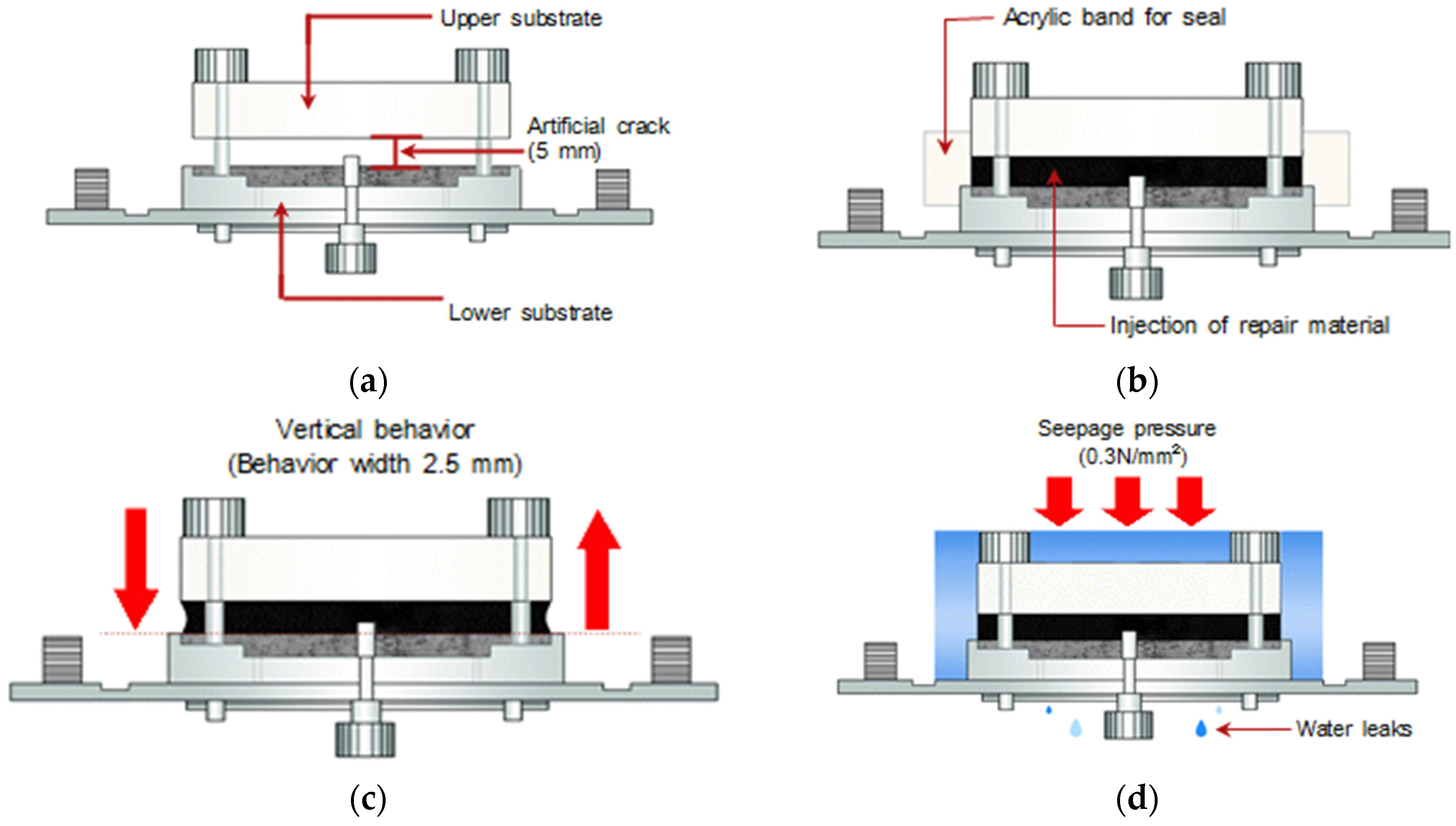
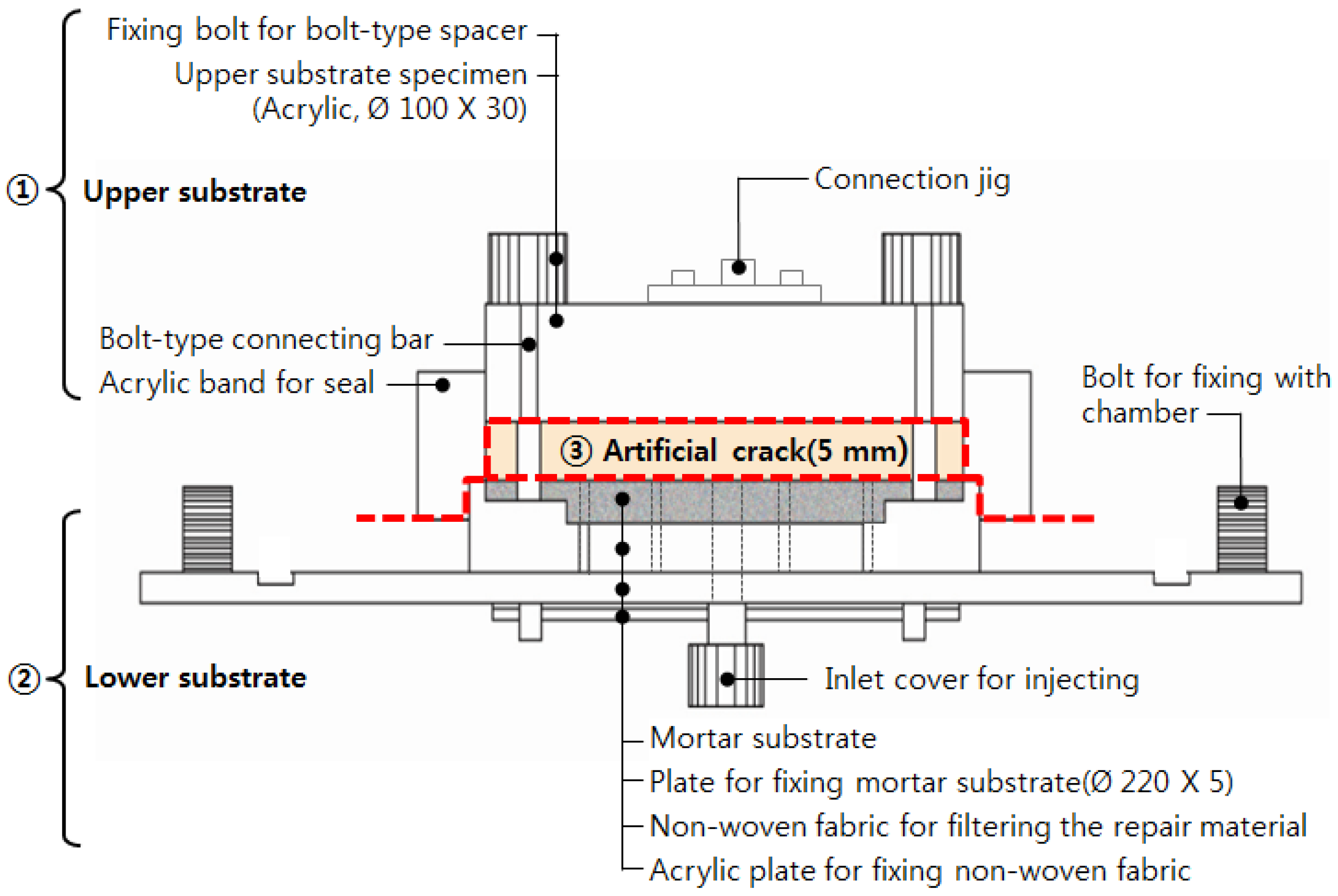
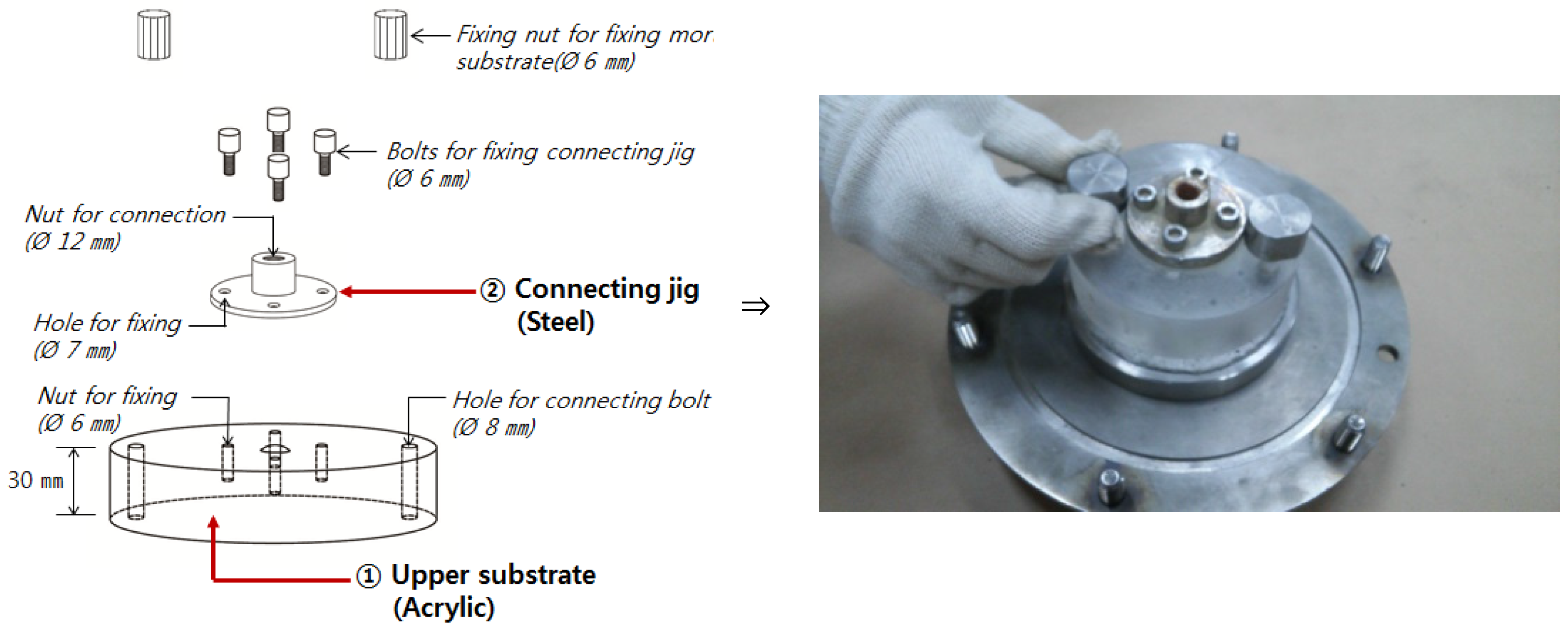
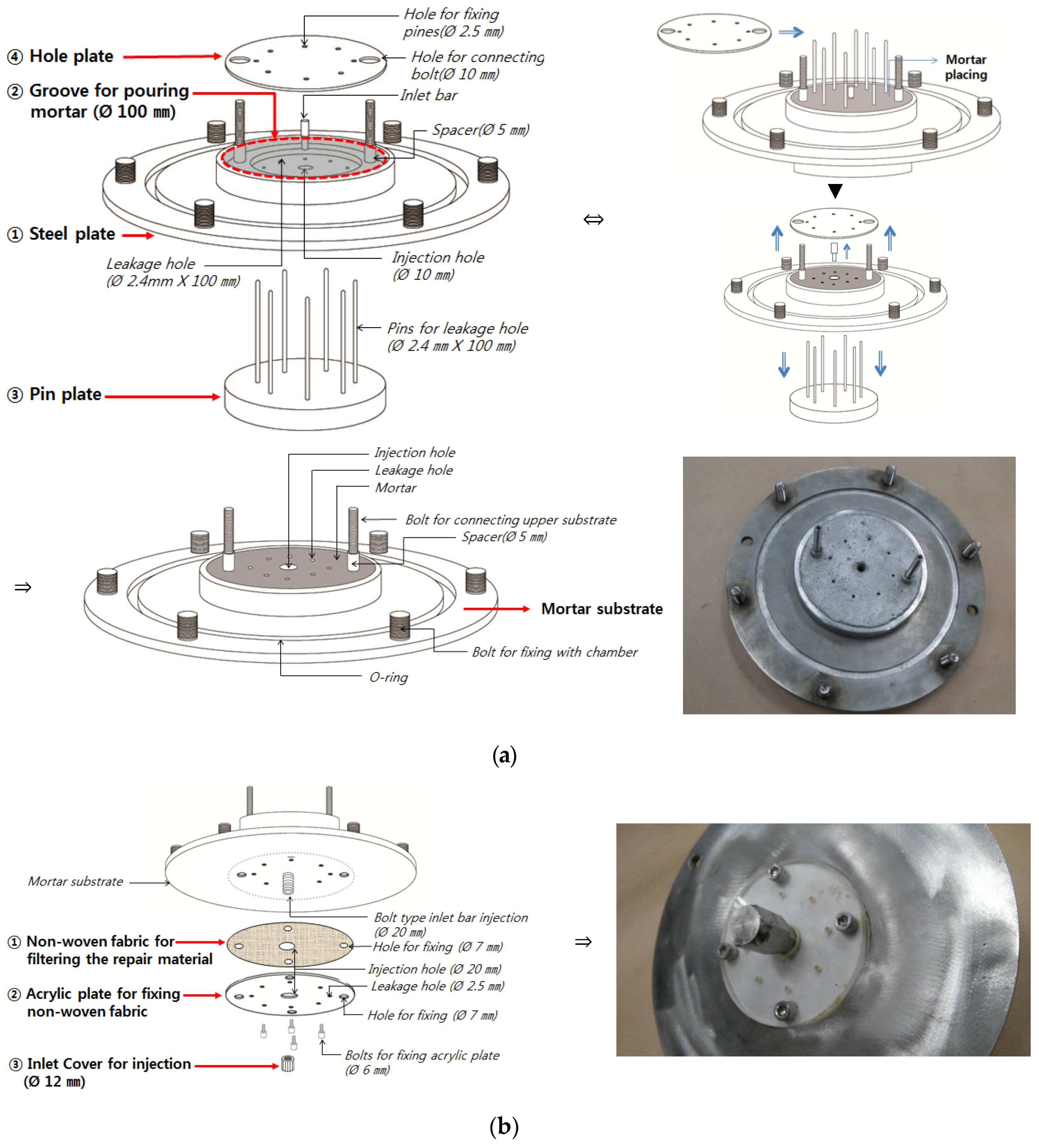



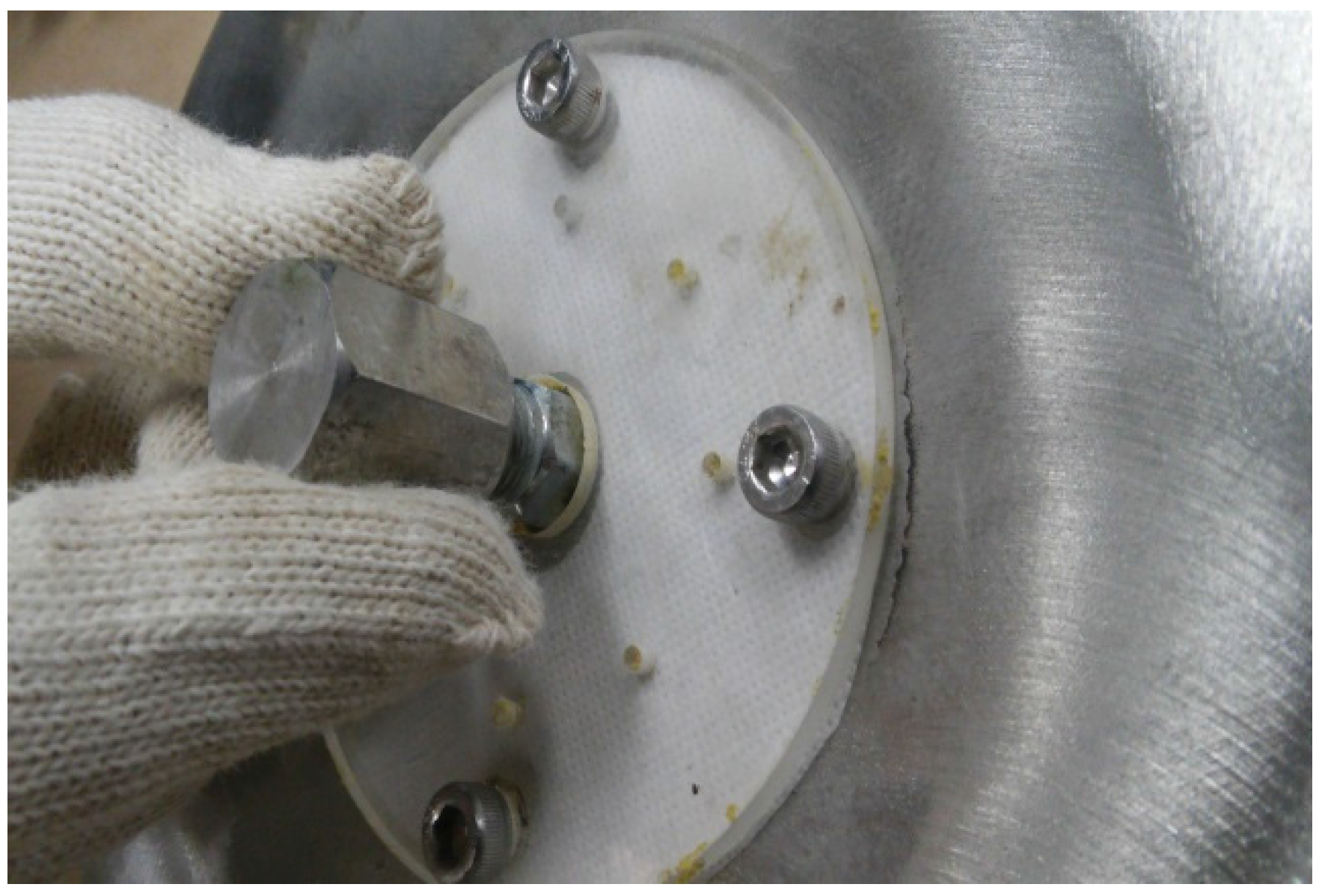


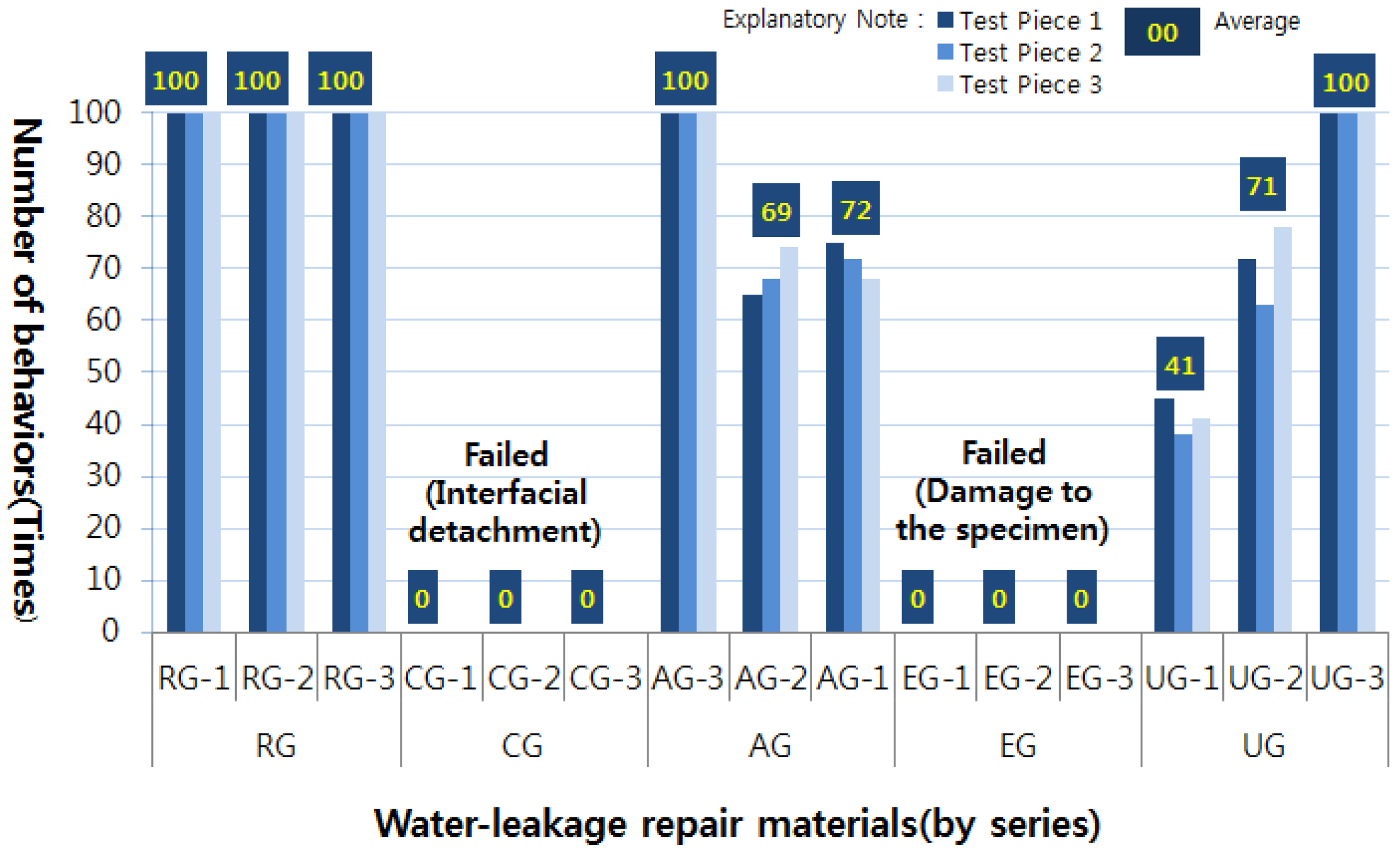
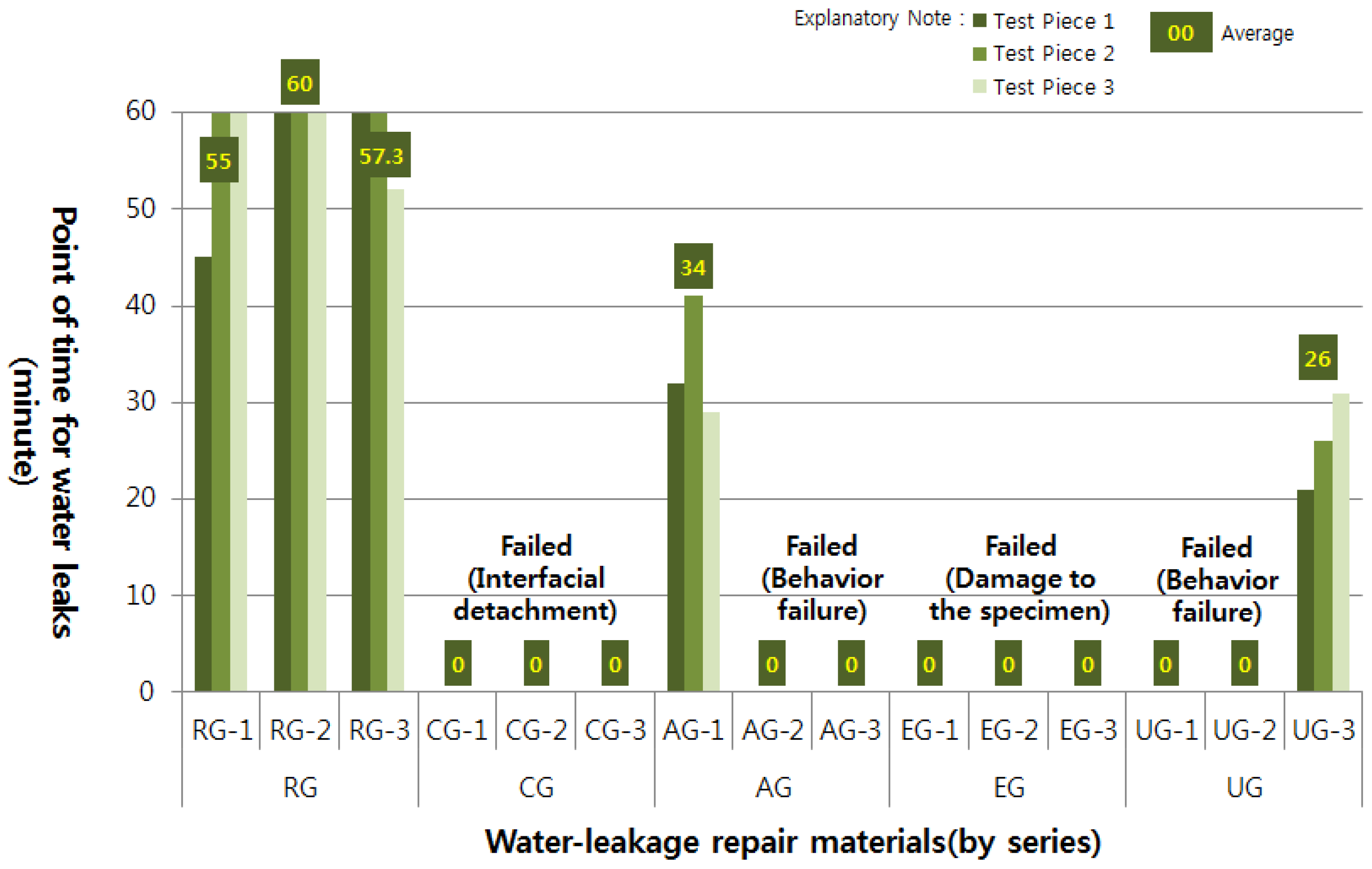
| Types | Components | Properties |
|---|---|---|
| RG-1 | Acrylamide, persulfate (mixed with one or two kinds of sodium, ammonium, and potassium), asphalt, and other additives | (1) Solids: 85%–90% (2) High-viscosity + low-viscosity non-curable composite liquid gel (3) Diaphragm structure with a sawtooth structure (diaphragm support structure) (4) Volume expansion due to the contact with water |
| RG-2 | Asphalt, inorganic filler for viscosity adjustment, processor oil, asphalt modifier, strength reinforcement agent, heat resistance reinforcement agent, adhesion reinforcement agent, anti-flow additives, used tires, aqueous modifier, etc. | (1) Solids: 95%–99% (2) High-viscosity non-curable mastic asphalt (3) Polar covalent bond structure of hydrophilic and lipophilic groups |
| RG-3 | Asphalt, bentonite, oil, rubber, water-soluble polymer resin, etc. | (1) Solids: 90%–95% (2) Highly adhesive non-curable bentonite rubberized asphalt |
| Types | Components | Properties |
|---|---|---|
| CG-1 | Cement, accelerator, fluidizing agent, water, other additives, etc. | (1) Solids: 97%–100% (2) Specific gravity: 1.9–2.0 (3) Non-shrink grout non-base material |
| CG-2 | Cement, sand, fluidizing agent, expansion agent, mixing water, etc. | (1) Solids: 95%–100% (2) Specific gravity: 1.57 (3) Fluidizing agent expansion material |
| CG-3 | Cement, fluidizing agent, curing regulator, water, other additives, etc. | (1) Solids: 97%–100% (2) Specific gravity: 1.32 (3) Ultra-rapid water-stop materials |
| Types | Components | Properties |
|---|---|---|
| AG-1 | Acrylate (metal hydroxide aqueous solution + acrylic acid + methacrylic acid), persulfate, amine (redox polymerization catalyst, acrylic acid meal salts, cross-linking agent, etc. | (1) Mixed viscosity: Less than 5 cps (2) Acrylate-based water-stop agent (3) Volume expansion: 400% (4) Curing time: 120 seconds |
| AG-2 | Acrylic acid metal salt, acrylamide, triethanolamine, glycerin, potassium femicyanide, sodium persulfate, etc. | (1) Mixed viscosity: Less than 3 cps (2) Acrylate-based water-stop agent (3) Volume swelling: 200% (4) Elongation: 70% after condensation |
| AG-3 | Main (sodium polyacrylate, acrylamide- sodium acrylate, water), hardener (sulfate compounds, water), accelerant (triethanolamine, water) | (1) Mixed viscosity: less than 20 cps (2) Acrylic seal grouting agent (3) Solubility: Soluble in water (4) Boiling point/melting point: 100 °C /−10 °C |
| Types | Components | Properties |
|---|---|---|
| EG-1 | Epoxy resin + amine (dry type) Main: Hardener = 2:1 | (1) Two-component low-viscosity epoxy non-shrink grout (2) Pot life: About 90min (20 °C) (3) Finger touch cure time: 50 min(20 °C) (4) Complete cure time: About 8 hr (35 °C) (5) Exterior color: Yellowish brown (main) |
| EG-2 | Epoxy resin + polyamidamine (wet type) Main: Hardener = 2:1 | (1) Two-component low-viscosity wet-type grout (2) Pot life: About 60min (25 °C) (3) Finger touch cure time: 18 hr (25 °C) (4) Complete cure time: 24–36 hr (25 °C) (5) Exterior color: Yellowish brown (main) |
| EG-3 | Elastic epoxy sealant Main: Hardener = 1:1 | (1) Two-component epoxy elastic sealing grout (2) Pot life: About 60min (23 °C) (3) Finger touch cure time: 14hr (23 °C) (4) Complete cure time: 24–36 hr (23 °C) (5) Exterior color: White paste (main) |
| Types | Components | Properties |
|---|---|---|
| UG-1 | Filled reactive polyurethane polymers Xylene: 4% | (1) One-component rapid-hardening elastic polyurethane (2) Solubility: Insoluble (reacts with water) (3) Specific gravity (20 °C): 1.26 (4) Flashpoint: 65 °C |
| UG-2 | Hydrophobic rigid non-shrink urethane | (1) 2-component non-shrink high-strength polyurethane (2) Viscosity : 532(resin) cps/23.1 °C (3) Initial/full cure pot life: 60 minutes at room temperature/24 hours at room temperature |
| UG-3 | Polyurethane resin Acetone (CH3CoCH3) Other additives | (1) One-component flexible urethane foam (2) Solubility: 1.3 g/100 ml (3) Specific gravity (20 °C): 1.37 (4) Viscosity: 200–500 cps/25 °C (5) Flashpoint: 0 °C |
| Division | Naked-Eye Observation | Comprehensive Judgment | ||
|---|---|---|---|---|
| RG |  |  |  | RG-1: Passed (leaks occurred) RG-2: Passed (fewer leaks occurred compared to RG-1) RG-3: Passed (fewer leaks occurred compared to RG-1) |
| RG-1 | RG-2 | RG-3 | ||
| CG |  |  |  | CG-1, 2, 3: Failed (interfacial detachment occurred immediately after the test) |
| CG-1 | CG-2 | CG-3 | ||
| AG |  |  |  | AG-1: Passed (excitation occurred) AG-2: Failed (interfacial detachment occurred at an average of 69 cycles) AG-3: Failed (interfacial detachment occurred at an average of 72 cycles) |
| AG-1 | AG-2 | AG-3 | ||
| EG |  |  |  | EG-1, 2, 3: Failed (specimen damage occurred) |
| EG-1 | EG-2 | EG-3 | ||
| UG |  |  |  | UG-1: Failed(interfacial detachment occurred at an average of 41 cycles) UG-2: Failed(interfacial detachment occurred at an average of 71 cycles) UG-3: Passed (excitation occurred) |
| UG-1 | UG-2 | UG-3 | ||
| Division | Presence and absence of water leakage | Comprehensive judgment | ||
|---|---|---|---|---|
| RG |  |  |  | RG-1: Permeable (1), not permeable (2) RG-2: Permeable (3) RG-3: Permeable (1), not permeable (2) |
| RG-1-① | RG-2 | RG-3-③ | ||
| CG | Failed (failure in crack behavior responsiveness) | CG-1, 2, 3: Failed (failure in crack behavior responsiveness occurred) | ||
| CG-1 | CG-2 | CG-3 | ||
| AG |  | Failed (failure in crack behavior responsiveness) | AG-1: Failed (permeable for 34 min on average) AG-2, 3: Failed (failure in crack behavior responsiveness occurred) | |
| AG-1 | AG-2 | AG-3 | ||
| EG | Failed (failure in crack behavior responsiveness) | EG-1, 2, 3: Failure (failure in crack behavior responsiveness occurred) | ||
| EG-1 | EG-2 | EG-3 | ||
| UG | Failed (failure in crack behavior responsiveness) |  | UG-1, 2: Failed (failure in crack behavior responsiveness occurred) UG-3: Failed (permeable for 26 min on average) | |
| UG-1 | UG-2 | UG-3 | ||
| Division | Crack Behavior Responsiveness Performance | Water Tightness Performance | Comprehensive Results | |||||
|---|---|---|---|---|---|---|---|---|
| S1 | S2 | S3 | S1 | S2 | S3 | |||
| RG | RG-1 | ● | ● | ● | × | ● | ● | Behavior test Responsive: 11EA (24.4%) Non-responsive: 34EA (75.6%) |
| RG | RG-2 | ● | ● | ● | ● | ● | ● | Non-responsive: 34EA (75.6%) |
| RG | RG-3 | ● | ● | ● | ● | ● | × | Behavior test Responsive: 11EA (24.4%) Non-responsive: 34EA (75.6%) |
| CG | CG-1 | × | × | × | × | × | × | Behavior test Responsive: 11EA (24.4%) Non-responsive: 34EA (75.6%) |
| CG | CG-2 | × | × | × | × | × | × | Behavior test Responsive: 11EA (24.4%) Non-responsive: 34EA (75.6%) |
| CG | CG-3 | × | × | × | × | × | × | Behavior test Responsive: 11EA (24.4%) Non-responsive: 34EA (75.6%) |
| AG | AG-1 | ● | × | × | × | × | × | Behavior test Responsive: 11EA (24.4%) Non-responsive: 34EA (75.6%) |
| AG | AG-2 | × | × | × | × | × | × | Permeability test Non-permeable: 7EA (15.6%) No test/permeable, separate body: 38EA (84.4%) |
| AG | AG-3 | × | × | × | × | × | × | Permeability test Non-permeable: 7EA (15.6%) No test/permeable, separate body: 38EA (84.4%) |
| EG | EG-1 | × | × | × | × | × | × | Permeability test Non-permeable: 7EA (15.6%) No test/permeable, separate body: 38EA (84.4%) |
| EG | EG-2 | × | × | × | × | × | × | Permeability test Non-permeable: 7EA (15.6%) No test/permeable, separate body: 38EA (84.4%) |
| EG | EG-3 | × | × | × | × | × | × | Permeability test Non-permeable: 7EA (15.6%) No test/permeable, separate body: 38EA (84.4%) |
| UG | UG-1 | × | × | × | × | × | × | Permeability test Non-permeable: 7EA (15.6%) No test/permeable, separate body: 38EA (84.4%) |
| UG | UG-2 | × | × | × | × | × | × | Permeability test Non-permeable: 7EA (15.6%) No test/permeable, separate body: 38EA (84.4%) |
| UG | UG-3 | × | × | ● | × | × | × | Permeability test Non-permeable: 7EA (15.6%) No test/permeable, separate body: 38EA (84.4%) |
© 2016 by the authors; licensee MDPI, Basel, Switzerland. This article is an open access article distributed under the terms and conditions of the Creative Commons Attribution (CC-BY) license (http://creativecommons.org/licenses/by/4.0/).
Share and Cite
Kim, S.-Y.; Oh, S.-K.; Kim, B. Artificial-Crack-Behavior Test Evaluation of the Water-Leakage Repair Materials Used for the Repair of Water-Leakage Cracks in Concrete Structures. Appl. Sci. 2016, 6, 253. https://doi.org/10.3390/app6090253
Kim S-Y, Oh S-K, Kim B. Artificial-Crack-Behavior Test Evaluation of the Water-Leakage Repair Materials Used for the Repair of Water-Leakage Cracks in Concrete Structures. Applied Sciences. 2016; 6(9):253. https://doi.org/10.3390/app6090253
Chicago/Turabian StyleKim, Soo-Yeon, Sang-Keun Oh, and Byoungil Kim. 2016. "Artificial-Crack-Behavior Test Evaluation of the Water-Leakage Repair Materials Used for the Repair of Water-Leakage Cracks in Concrete Structures" Applied Sciences 6, no. 9: 253. https://doi.org/10.3390/app6090253






